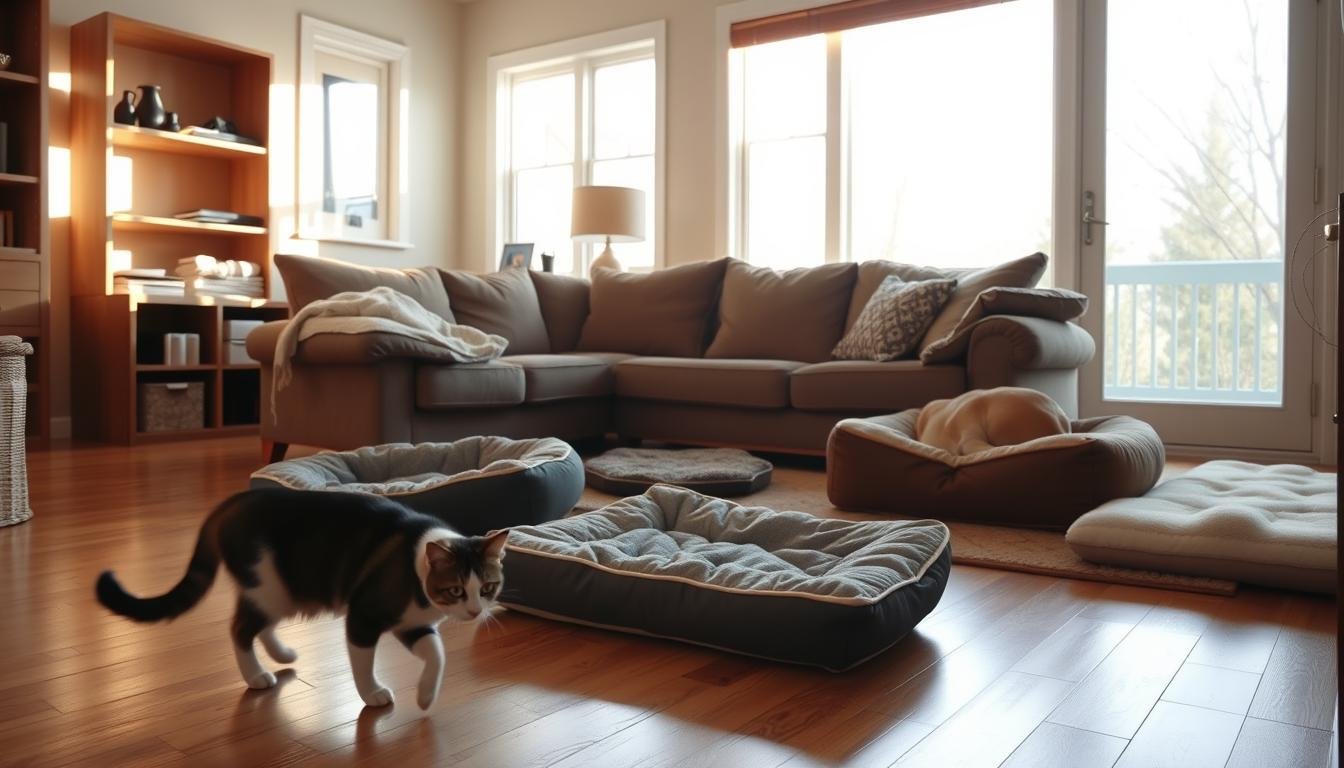Did you know 70% of pet owners treat their pets like family? Yet, 60% have seen their pets get hurt at home. This shows how important it is to make your home safe for pets.
A safe space is more than a cozy bed. It’s a lifeline. Pets with a safe spot are 40% less anxious, showing comfort is key to their happiness. Make sure your pet has a clean, draft-free spot to rest. This could be a crate or a quiet corner.
Keeping kitchens and garages off-limits can prevent many accidents. Over 80% of pet mishaps happen in these areas, but only 20% of owners use gates. Even small actions, like securing cables or storing toxins safely, can make a big difference. A safe home means peace of mind for you and your pet.
Key Takeaways
- 70% of pet owners view pets as family, but 60% face preventable accidents—showcasing the gap between care and preparedness.
- Pets with safe spaces have 40% lower anxiety rates, proving designated areas are vital for emotional health.
- 80% of accidents happen in high-risk rooms like kitchens—use baby gates to block access.
- Mental stimulation through play and safe toys prevents boredom and destructive behavior.
- Hydration matters: pets with constant fresh water are 25% more likely to stay healthy.
Understanding Your Pet’s Needs
Starting with holistic pet care means knowing what your pet needs. Each animal has its own comfort, emotional, and physical needs. By understanding these, you can create a space where pets can flourish.
The Importance of Comfort
Comfort starts with safe spaces. Dogs and cats need quiet spots to relax when they’re stressed. In homes with more than one pet, having enough beds and toys helps avoid fights.
Keeping pets hydrated is also crucial. Make sure to refill their water bowls twice a day. Also, keeping their living area clean is important. Fish tanks need weekly cleaning to prevent sickness.
Emotional Well-Being
Emotional health is linked to behavior. In the U.S., over 56% of dogs and 60% of cats are overweight, often due to stress eating. Regular exercise helps prevent bad habits from boredom.
Outdoor cats face dangers like traffic and predators. Keeping them indoors with toys can improve their mental health.
Physical Requirements
- Puppies up to 12 weeks need 4 meals daily; adults can transition to 1-2 meals.
- Exercise varies by breed: active dogs like Labs need 60+ minutes daily, while seniors may need shorter walks.
- Collars must include ID tags and microchips for safety.
Annual vet visits and vaccinations are key for preventive care. In the U.S., 70% of dogs and 50% of cats get vaccinated. Holistic pet care aims to support their health and happiness for life.
Choosing the Right Space for Your Pet
Creating a space that meets your pet’s physical and emotional needs is key to good pet care. A well-designed area supports natural

Indoor vs. Outdoor Considerations
Indoor spaces shield pets from extreme weather and dangers like predators. Outdoor areas need secure fencing and daily supervision. Over 60% of owners note indoor setups improve pet happiness by reducing anxiety.
For example, cats often prefer indoor comfort, while active dogs may enjoy supervised outdoor time. Assess your pet’s personality and local risks before deciding.
Area Size and Layout
Space must match your pet’s size and habits. A cat’s area needs vertical climbing options, while large dogs require room to move freely. Use storage spaces like under stairs or closets—70% of owners use these spots for pet zones.
Consider these tips:
- Cats: Add shelves or cat trees for climbing.
- Dogs: Include chew toys and bedding in a corner of a high-traffic room.
- Use machine-washable beds and durable flooring (85% of owners prioritize this).
Proximity to Family Activities
Pets thrive near family hubs. A cozy corner near the kitchen or living room keeps them connected without overcrowding. Quiet zones nearby help reduce separation anxiety. 75% of owners say calm areas improve sleep and calmness.
Place feeding stations (40% use these) close to your pet’s main space for convenience.
Pet-Proofing Your Home
Ensuring pet safety begins with a safe home. Over 80% of pet accidents happen at home. Also, 1 in 3 pets face health risks from household items. These
Securing Hazardous Materials
Keep these dangers out of reach:
- Toxic foods (chocolate, onions) – 20% of common foods pose risks
- Poisonous plants like lilies and poinsettias
- Medications: 25% of owners leave them accessible
Managing Cords and Cables
Electrical cords cause 40% of pet injuries. Use these solutions:
- Wrap cords with protective sleeves
- Apply bitter-tasting deterrent sprays
- Store cables in hidden cable boxes
Safe Storage for Pet Supplies
Use this comparison to organize supplies:
| Risk | Solution |
|---|---|
| Open trash cans | Use latched containers |
| Medications in reach | Lock cabinets or use high shelves |
| Cleaning supplies | Store in sealed containers |
Small steps like these protect pets and prevent accidents. Make these changes to create a safer home for your furry friend.
Safe Zones for Pets
A safe zone is a place where pets feel safe. More than 90% of vets say these spaces are key for pet care. They help pets relax, with 70% of owners seeing better behavior. The space should be welcoming and easy to get to.
Designating a Personal Space
Let pets pick their own spot. Studies show dogs find peace 40% more in their own space. Use it for crate training without punishment. 50% of owners see less anxiety when pets eat there.
Creating a Cozy Nook
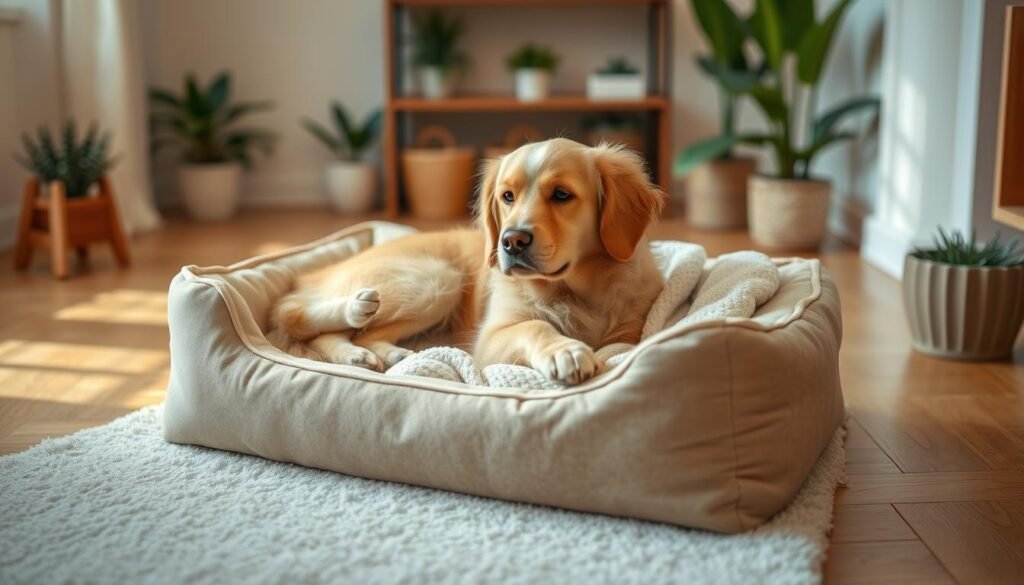

Make it cozy with soft bedding and toys. Dogs with fun toys are 50% less destructive when alone. Play calming music to reduce anxiety by 20%. Add pheromone diffusers like Adaptil for extra calm.
Using Gates and Barriers
Baby gates or pens set boundaries. 65% of dogs go to their zone when stressed. Keep it safe from dangers. Consistency helps with training.
“A safe zone isn’t just physical—it’s emotional security. 80% of owners report calmer pets with these spaces.”—Animal Behavior Journal
Safe zones are crucial for less anxiety. Use them with crate training for puppies. Over 75% of owners see better behavior after setting them up.
Selecting the Right Furniture
Keeping your furniture safe and pet-friendly starts with the right materials. Pets like to scratch and chew, so you need furniture that’s both stylish and tough.
affects your furniture, so picking the right pieces is key to avoiding damage.
Pet-Friendly Materials
Look for fabrics that can handle claws and spills. Leather and microfiber are great because they can stand up to scratches and spills. Crypton-treated fabrics even repel dirt and odors. Microsuede and polyurethane keep pet hair from sticking.
For wood furniture, solid hardwoods like oak or walnut are better than veneers because they last longer.
Avoiding Sharp Edges
- Go for furniture with rounded corners and legs to prevent injuries during play.
- Urethane finishes on wood surfaces are better at resisting scratches than paint.
- Metal inlays on table legs can help stop pets from chewing.
Choosing Durable Fabrics
Dark colors like brown or grey are better at hiding stains than light ones. Low-pile fabrics and tight-weave materials, like denim, make it harder for pets to scratch and easier to clean. Remember to reapply protectors like Scotchgard every 6–12 months to keep your fabrics in good shape. Keeping your pet’s nails trimmed and grooming them regularly can also help prevent damage.
Temperature Control for Pet Comfort
“Pets can’t cool down like humans, making temperature control vital for their safety.”
Keeping your home at a stable temperature is key for your pet’s health. Extreme temperatures can stress them out. Here are some tips to keep your home comfortable for your furry friend.
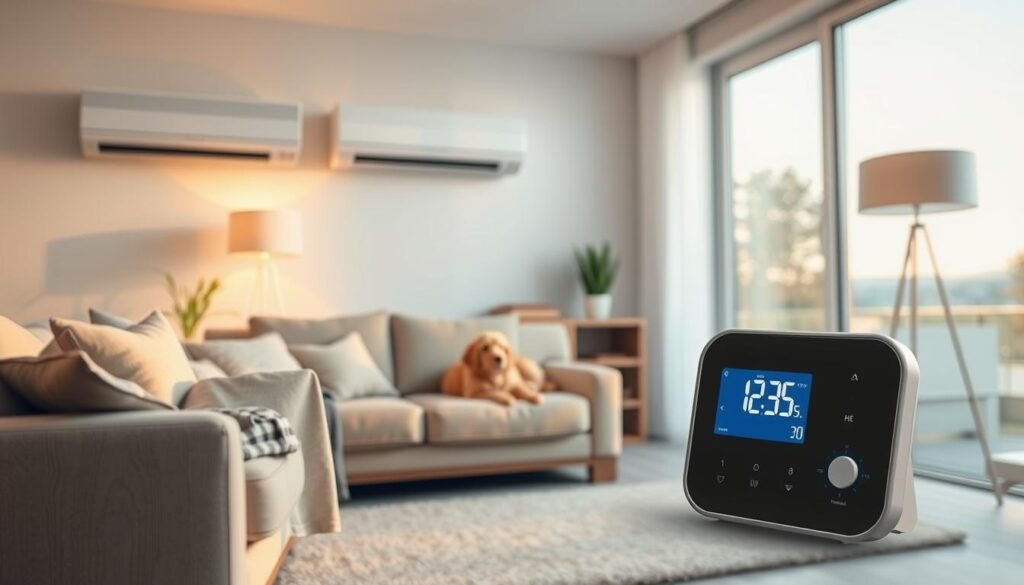
Summer Cooling Tips
For dogs, keep the house between 75–78°F. Use fans or misters to keep the air moving. Make sure your pet doesn’t get too much sun. Signs they’re too hot include heavy breathing or acting tired.
- Provide ice cubes or frozen treats for cooling
- Install window shades to block hot sunlight
- Check humidity levels—keep them under 50% to prevent dehydration risks
Winter Heating Techniques
For most pets, keep the house at 68–72°F. Short-haired or small pets might need it warmer, at 70–75°F. Use warm bedding and keep drafts away from windows.
| Season | Temp Range | Main Tips |
|---|---|---|
| Summer | 75–78°F | Fans, shaded areas |
| Winter | 68–72°F | Insulated bedding, draft blockers |
Regular HVAC maintenance is important. It keeps the air clean and your system running well. Change filters every 1–3 months to cut down on pet dander. These steps help keep your pet comfortable all year, supporting their health and happiness.
Maintaining Indoor Air Quality
Clean air is key for your pet’s health. Bad air can cause allergies, breathing problems, and skin issues. Simple steps like good ventilation and safe plants help keep your home healthy for both you and your pets.
Importance of Ventilation
Good air flow helps remove allergens and smells. Open windows every day and use fans in wet areas. HEPA vacuums can cut dander by half.
Use air purifiers like the Trane Envirowise to clean 99.98% of particles. Don’t forget to change your HVAC filters yearly to stop mold. Keep humidity between 30–50% with dehumidifiers to avoid mold.
Plants That Are Safe for Pets
Choose safe plants to improve air without risks. Spider plants, Boston ferns, and bamboo palms are good choices. Stay away from lilies, poinsettias, and sago palms, as they are toxic.
These plants not only clean the air but also make your home look nice.
- Safe picks: Spider plant, Boston fern, areca palm
- To avoid: Lilies, dieffenbachia, and philodendron
Combining plants with air purifiers like Trane’s systems is effective. This mix helps your pet’s health and reduces human allergies. Clean air strengthens their immune system, making them more comfortable all year.
Using Safe Cleaning Products
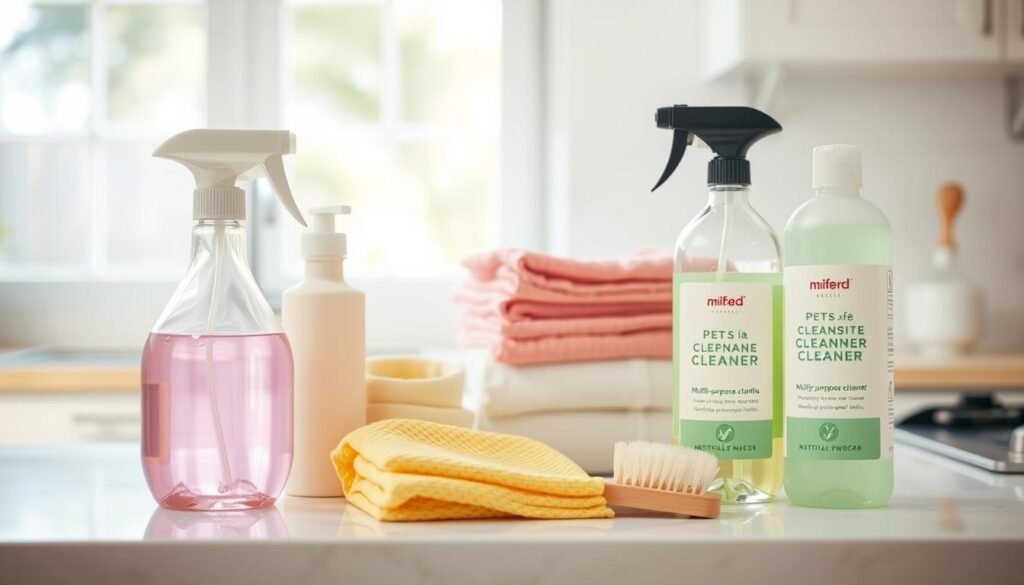
Keeping your home clean doesn’t mean you have to risk your pet’s health. Many cleaners have hidden dangers, with over 30% of pet poison cases linked to them. Cats and dogs can get sick from breathing in or touching these chemicals. It’s important to make safe choices for your pets.
Toxic Chemicals to Avoid
- Ammonia, bleach, and phenols are big risks, found in many sprays.
- Ingredients like ethanol or ammonia can burn skin or harm inside when licked or inhaled.
- Over 8.3% of ASPCA poison calls involve these chemicals, showing their danger.
Pet-Friendly Alternatives
Use white vinegar mixed with water as a natural cleaner for floors and surfaces. Brands like ECOS or Mrs. Meyer’s are safe for pets. Many pet owners keep cleaners out of reach, but make sure areas are dry before letting pets back.
Changing a few things can make a big difference. Look for EPA Safer Choice labels and keep pets away while cleaning. Choosing safe, non-toxic cleaners means you can keep your home clean without risking your pet’s health.
Training Safe Behavior
Behavior issues are the leading cause of dogs being returned to shelters.
Positive pet training builds trust and turns instincts into safe habits. Start with basics like “come” and “stay” to prevent dangers. For example, darting into traffic.
Consistent short sessions (10-15 minutes daily) work better than long drills. Use treats to reward calm responses. This reinforces good
Basics of Obedience Training
- Teach “leave it” to stop chewing hazards like cables.
- “Wait” at doorways prevents escapes during walks.
- Repeat commands drills weekly to build muscle memory.
| Command | Safety Purpose |
|---|---|
| “Stay” | Keeps pets from jumping into cars or fights. |
| “Come” | Recalls in emergencies like loose leashes. |
Reducing Anxiety and Stress
Dogs with secure attachment styles (40% of pets) handle stress better. Create calm zones with soft blankets and toys. Use pheromone sprays or calming music during storms. Training builds confidence—like gradual exposure to visitors reduces barking.
Secure attachment lets pets see owners as safe bases, boosting exploration without fear. Reward calmness during vet visits or thunder. Training turns anxious reactions into relaxed responses, enhancing safety and trust.
Socialization for a Happy Pet
Socialization is key for a pet’s happiness and health. Puppies and kittens learn important skills between 3–14 weeks. Positive interactions help them face fear and aggression.
Giving your pet the choice to leave a stressful situation boosts their confidence and reduces anxiety. Never use their safe space for punishment to avoid negative associations.
Benefits of Interaction with Other Pets
Playdates teach pets about body language and sharing. Early socialization reduces aggression by 70%. Regular play boosts confidence by 50%.
- Start with short, calm play sessions.
- Supervise interactions to avoid overstimulation.
- Use treats to reward calm behavior.
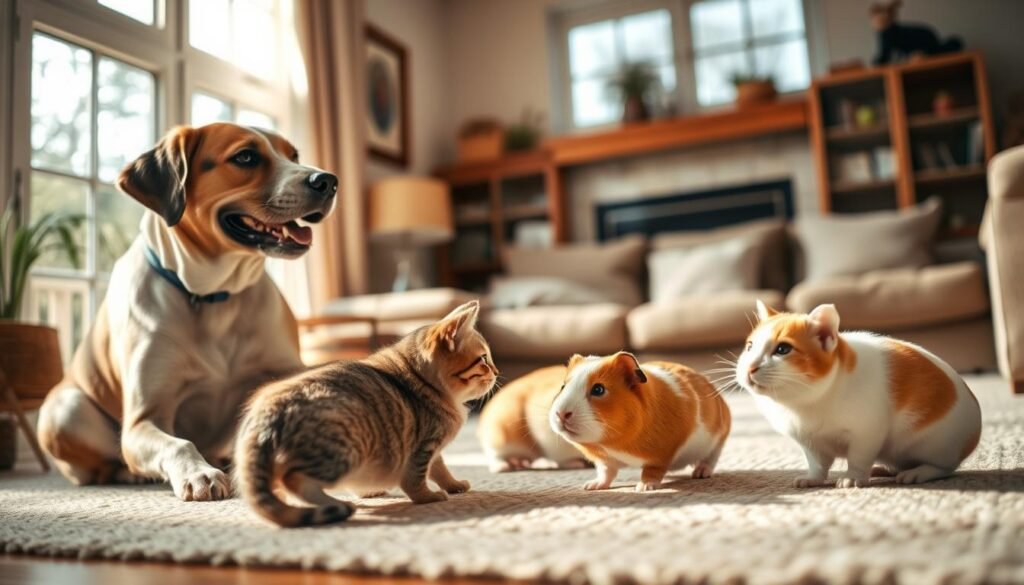
Introducing New People
Gradual exposure helps pets get used to visitors. Let them approach at their own pace to avoid stress. Socialization classes increase comfort by 80%.
Watch for signs like tucked tails or flattened ears. A 40% reduction in stress comes with consistent efforts. Always prioritize their comfort to strengthen trust.
Healthy socialization reduces aggression risks and improves their quality of life. Building these skills creates pets who thrive in family settings, enhancing animal wellness long-term.
Veterinary Care and Regular Check-Ups
Regular visits to veterinary services are key for pets’ safety. Catching diseases early, like diabetes or heart disease, helps a lot. It saves stress and money later. Even if pets look fine, they might have hidden problems. Annual exams help find these issues before they get worse.
Getting core vaccinations and preventive care is a must. Puppies and kittens need shots every 3–4 weeks until they’re 20 weeks old. Adult pets need yearly check-ups, and seniors over seven should go every six months. These visits include bloodwork, X-rays, and dental exams to check organ health and catch age-related problems.
- Annual heartworm tests for dogs (per American Heartworm Society)
- FeLV/FIV testing for cats based on lifestyle risks
- Senior pets need yearly blood panels to track kidney or thyroid health
Experts suggest keeping a health diary for your pet. Record vaccinations, medications, and any behavioral changes. Sudden changes in energy or appetite could mean serious health issues. Many owners wait until symptoms show up, but early care can prevent big problems.
“Preventive care adds years to pets’ lives. It’s an investment in their well-being and your peace of mind.” — Dr. Sarah Collins, DVM
Prices differ based on where you live and your pet’s age. Basic exams start at $40, while senior bloodwork can cost up to $200. Wellness plans or insurance can help make care more affordable. Compare prices: urban areas like San Francisco charge 50% more than rural areas. Local shelters or non-profits might offer cheaper services for low-income owners.
Working with a trusted vet is important for your pet’s health. Plan visits based on your pet’s age and lifestyle. Your vet can create a plan that fits your pet’s health and your budget.
Emergency Preparedness for Pet Owners
Emergency planning is key for pet care that many owners overlook. Only 56% of pet owners have a disaster plan. Yet, 71% think having one would make a big difference. Start now to keep your pet safe during storms, fires, or when you need to leave quickly.
Creating a Pet Emergency Kit
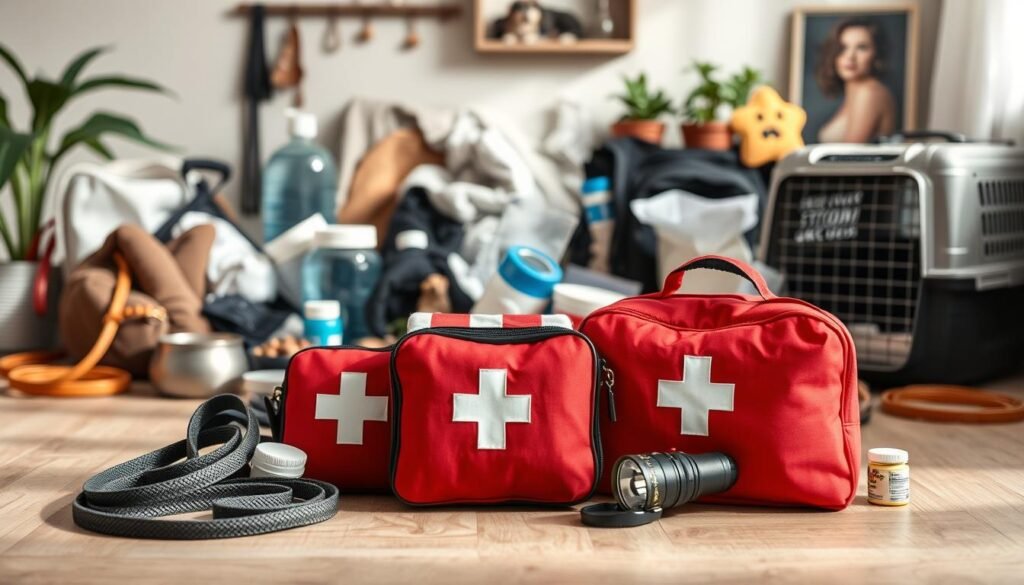
- Food: Keep at least five days of sealed canned or dry food. Also, have 7 days of bottled water
- Medications: Change supplies every 2 months to keep them fresh
- Comfort items: Familiar blankets can reduce stress by 30%
- Essentials: Make sure to have microchip registration, vet records, and a 24-hour emergency clinic contact
Important Contacts and Resources
- Save 2 emergency contacts, including a 24-hour vet
- Find pet-friendly hotels and shelters near evacuation routes
- Include poison control numbers and microchip registration details
Keep kits up to date and practice evacuation drills. Microchips and ID tags can help prevent loss—25% of pets are not protected. Being ready ensures your pet’s safety in any emergency.
Community Resources for Pet Owners
Expanding your pet’s safe space means tapping into local resources. From services to social spots, these options help keep pets healthy and connected to their communities.
Local Pet Services
Reputable providers for pet grooming and pet nutrition advice are vital. Programs like the Velvet Financial Assistance Fund offer up to $750 for emergencies. Check clinics such as the Anti-Cruelty Society’s Chicago locations for affordable options. Ask about staff credentials and client reviews to ensure reliability.
Many veterinary schools run clinics with reduced fees. Nutritionists can guide diets to prevent health issues. Organizations like The Pet Fund help with specialized care but may have waitlists.
Pet-Friendly Spaces and Events
Parks and trails let pets exercise safely when supervised. Events like dog-friendly festivals encourage socialization—follow rules to avoid disruptions. Pet food pantries in areas like Detroit or Portland help families in need. Attend adoption drives or training classes to build bonds while exploring options.
Always clean up after pets in public. Resources like Paws 4 A Cure offer financial aid for chronic conditions. By using these tools, you extend your pet’s safe zone beyond home, fostering health and community ties.

